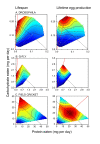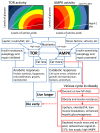Macronutrient balance and lifespan
- PMID: 20157561
- PMCID: PMC2815731
- DOI: 10.18632/aging.100098
Macronutrient balance and lifespan
Abstract
Dietary restriction (DR) without malnutrition is widely regarded to be a universal mechanism for prolonging lifespan. It is generally believed that the benefits of DR arise from eating fewer calories (termed caloric restriction, CR). Here we argue that, rather than calories, the key determinant of the relationship between diet and longevity is the balance of protein to non-protein energy ingested. This ratio affects not only lifespan, but also total energy intake, metabolism, immunity and the likelihood of developing obesity and associated metabolic disorders. Among various possible mechanisms linking macronutrient balance to lifespan, the nexus between the TOR and AMPK signaling pathways is emerging as a central coordinator.
Keywords: AMPK; TOR; caloric restriction; dietary restriction; geometric framework; nutrient balance; protein.
Conflict of interest statement
The authors have no conflict of interests to declare.
Figures


Similar articles
-
Macronutrients and caloric intake in health and longevity.J Endocrinol. 2015 Jul;226(1):R17-28. doi: 10.1530/JOE-15-0173. Epub 2015 May 28. J Endocrinol. 2015. PMID: 26021555 Free PMC article. Review.
-
Role of TOR signaling in aging and related biological processes in Drosophila melanogaster.Exp Gerontol. 2011 May;46(5):382-90. doi: 10.1016/j.exger.2010.11.036. Epub 2010 Dec 2. Exp Gerontol. 2011. PMID: 21130151 Free PMC article. Review.
-
Drosophila as a model for ageing.Biochim Biophys Acta Mol Basis Dis. 2018 Sep;1864(9 Pt A):2707-2717. doi: 10.1016/j.bbadis.2017.09.016. Epub 2017 Sep 28. Biochim Biophys Acta Mol Basis Dis. 2018. PMID: 28964875 Review.
-
Target of rapamycin signalling mediates the lifespan-extending effects of dietary restriction by essential amino acid alteration.Aging (Albany NY). 2014 May;6(5):390-8. doi: 10.18632/aging.100665. Aging (Albany NY). 2014. PMID: 24861087 Free PMC article.
-
Calories or protein? The effect of dietary restriction on lifespan in rodents is explained by calories alone.Exp Gerontol. 2016 Dec 15;86:28-38. doi: 10.1016/j.exger.2016.03.011. Epub 2016 Mar 19. Exp Gerontol. 2016. PMID: 27006163 Review.
Cited by
-
Cost of reproduction in the Queensland fruit fly: Y-model versus lethal protein hypothesis.Proc Biol Sci. 2012 Dec 22;279(1749):4893-900. doi: 10.1098/rspb.2012.2033. Epub 2012 Oct 24. Proc Biol Sci. 2012. PMID: 23097519 Free PMC article.
-
Dietary protein and lifespan across the metamorphic boundary: protein-restricted larvae develop into short-lived adults.Sci Rep. 2015 Jun 29;5:11783. doi: 10.1038/srep11783. Sci Rep. 2015. PMID: 26119686 Free PMC article.
-
Sex-specific effects of protein and carbohydrate intake on reproduction but not lifespan in Drosophila melanogaster.Aging Cell. 2015 Aug;14(4):605-15. doi: 10.1111/acel.12333. Epub 2015 Mar 23. Aging Cell. 2015. PMID: 25808180 Free PMC article.
-
A glucose-supplemented diet enhances gut barrier integrity in Drosophila.Biol Open. 2021 Mar 8;10(3):bio056515. doi: 10.1242/bio.056515. Biol Open. 2021. PMID: 33579694 Free PMC article.
-
Macronutrient intake and simulated infection threat independently affect life history traits of male decorated crickets.Ecol Evol. 2020 Sep 22;10(20):11766-11778. doi: 10.1002/ece3.6813. eCollection 2020 Oct. Ecol Evol. 2020. PMID: 33144999 Free PMC article.
References
-
- Simpson SJ, Raubenheimer D. Caloric restriction and aging revisited: the need for a geometric analysis of the nutritional bases of aging. J Gerontol A Biol Sci Med Sci. 2007;62:707–713. - PubMed
-
- Fanson BG, Weldon CW, Pérez-Staples D, Simpson SJ, Taylor PW. Nutrients, not caloric restriction, extend lifespan in Queensland fruit flies (Bactrocera tryoni) Aging Cell. 2009;8:514–523. - PubMed
MeSH terms
Substances
LinkOut - more resources
Full Text Sources
Other Literature Sources
Medical
Molecular Biology Databases
